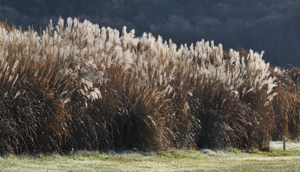Via Scoop.it – AnnBot
Alan Spedding, Rusource Briefing 1381: Miscanthus breeding Researchers at the Institute of Biological, Environmental and Rural Sciences (IBERS) at the University of Aberystwyth have been undertaking a large-scale study of Miscanthus to provide improved varieties for energy production. One way is to grow varieties which flower at just the right time and so maximise yields. Some types flower as early as June, others as late as November and some didn’t flower at all. This diversity is promising as it will allow breeders to develop varieties that can flower at the time of year that best suits the environment in which they are grown. BBSRC Follow Alan Spedding on Twitter @RuSource Subscribe to Rusource Briefings http://www.nationalrural.org/organisation.aspx?id=886c6950-1d3f-44d5-a362-324423edd7ea
Show original





Miscanthus; crop of the future
Miscanthus Giganteus has been categorised as a “wonder” crop of the future, with energy efficiency qualities and a known leader in the biofuels market.
N.C State University has been studying five acres of the energy crop at the Mountain Research Horticultural Research station and have found that energy grasses are set to be the most favourable crop for interested farmers.
http://www.insightgroupplc.com
Miscanthus Giganteus once established can yield for up to 20-years with low year-on-year maintenance. Miscanthus produces more than 2½ times the ethanol of corn and yielding 2-4 times more dried tonnes than Switchgrass. An acre of the energy crop can produce 12-1 tons of biomass, producing around 1,200 gallons of ethanol fuel.
Steven Burke, president of the Biofuels Center of North Carolina said that it is not impossible to achieve the policymaker’s ambitious goal of producing 10 percent of the state’s transportation fuels from ethanol sources.” But he cautioned that it can only be achieved with a state that is peppered with biofuels facilities.
Miscanthus standing 20 feet high attracted around 50 interested biofuels experts, farmers and academics to the research station to evaluate the potential for the grass. The rapid growth, low mineral content and high biomass yield has propelled Miscanthus to the top biofuel product in the U.S.